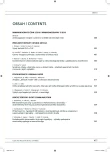“Default Mode” Network Analysis in Healthy Volunteers
Authors:
L. Krajčovičová; M. Mikl; R. Mareček; I. Rektorová
Authors‘ workplace:
I. neurologická klinika LF MU a FN u sv. Anny v Brně
Published in:
Cesk Slov Neurol N 2010; 73/106(5): 517-522
Category:
Original Paper
Overview
The default mode network (DMN) is an organized network of brain structures involved in brain activity that may be observed in the resting state. In the course of the performance of an experimental cognitive task during functional MRI examination (fMR), these regions manifest as “deactivations”. The main areas involved in this network are the ventromedial prefrontal cortex/anterior cingulate cortex, posterior cingulate cortex/precuneus and angular gyrus/inferior parietal cortex. In a group of 10 healthy volunteers we employed the following approaches to the detection of DMN: deactivations related to a visual spatial memory task; seed functional connectivity from the specific region of interest (cluster posterior cingulate cortex/precuneus); and independent component analysis (ICA). We then sought correlations between the MRI signal and the results of the visuo-spatial memory task and the Addenbrook cognitive examination (ACE), in concrete terms with the ACE verbal fluency subscore (VFT), and memory. The ICA approach revealed a higher correlation rate with the results from functional connectivity compared with pure deactivation mapping. We found correlation between MRI signal in the cluster posterior cingulate cortex/precuneus and VFT performance.
Key words:
default mode network – functional magnetic resonance – cognitive task – deactivations – resting state
Sources
1. Raichle ME, Snyder ZE. A default mode of brain function: a brief history of an evolving idea. Neuroimage 2007; 37(4): 1083–1090.
2. Robinson S, Basso G, Soldati N, Sailer JJ, Bruzzone L, Krypsin-Exner I et al. A resting state network in the motor control circuit of the basal ganglia. BMC Neurosci 2009; 10 : 137.
3. Calhoun VD, Kiehl KA, Pearlson GD. Modulation of temporally coherent brain network estimated using ICA at rest and during cognitive tasks. Hum Brain Mapp 2008; 29(7): 828–838.
4. Broyd SJ, Demanuele C, Debener S, Helps SK, James CJ, Sonuga-Barke EJ. Default-mode brain dysfunction in mental disorders: a systematic review. Neurosci Biobehav Rev 2009; 33(3): 279–296.
5. Greicius MD, Krasnow B, Reiss AL, Menon V. Functional connectivity in the resting brain: A network analysis of the default mode hypothesis. Proc Natl Acad Sci U S A 2003; 100(1): 253–258.
6. Hummelová-Fanfrdlová Z, Rektorová I, Sheardová K, Bartoš A, Línek V, Ressner P et al. Česká adaptace Addenbrookského kognitivního testu. Československá psychologie 2009; 53 : 376–388.
7. Rabin ML, Narayan VM, Kimberg DY, Casasanto DJ, Glosser G, Tracy JI et al. Functional MRI predicts post-surgical memory following temporal lobectomy. Brain 2004; 127(10): 2286–2298.
8. Greicius MD, Srivastava G, Reiss AL, Menon V. Default-mode network activity distinguishes Alzheimer´s disease from healthy aging: Evidence from functional MRI. Proc Natl Acad Sci U S A 2004; 101(13): 4637–4642.
9. Gusnard DA, Raichle ME. Searching for a baseline: functional imaging and the resting human brain. Nat Rev Neurosci 2001; 2(10): 685–694.
10. Wang L, Zang Y, He Y, Liang M, Zhang X, Tian L et al. Changes in hippocampal connectivity in the early stages of Alzheimer’s disease: evidence from resting state fMRI. Neuroimage 2006; 31(2): 496–504.
11. Rombouts SA, Barkhof F, Goekoop R, Stam CJ, Scheltens P. Altered resting state network in mild cognitive impairment and mild Alzheimer’s disease: an fMRI study. Hum Brain Mapp 2005; 26(4): 231–239.
12. Harrison BJ, Pujol J, López-Solà M, Hernández-Ribas R, Deus J, Ortiz H et al. Consistency and functional specialization in the default mode brain network. Proc Natl Acad Sci U S A 2008; 105(28): 9781–9786.
13. Supekar K, Menon V, Rubin D, Musen M, Greicius MD. Network analysis of intrinsic functional brain connectivity in Alzheimer’s disease. PLoS Comput Biol 2008; 4(6): e1000100.
14. Cavanna AE, Trimble MR. The precuneus: a review of its functional anatomy and behavioral correlates. Brain 2006; 129(3): 564–583.
15. Briand LA, Gritton H, Howe WM, Zoung DA, Sarter M. Modulators in concert for cognition: Modulator interactions in the prefrontal cortex. Prog Neurobiol 2007; 83(2): 69–91.
16. Dumontheil I, Burgess PW, Blakemore SJ. Development of rostral prefrontal cortex and cognitive and behavioural disorders. Dev Med Child Neurol 2008; 50(3): 168–181.
17. Lepage M, Ghaffar O, Nyberg L, Tulving E. Prefrontal cortex and episodic memory retrieval mode. Proc Natl Acad Sci U S A 2000; 97(1): 506–511.
18. Ranganath C, Johnson MK, D’Esposito M. Left anterior prefrontal activation increases with demands to recall specific perceptual information. J Neurosci 2000; 20(22): 108.
19. Johnson MK, Raye CL, Mitchell KJ, Touryan SR, Greene EJ, Nolen-Hoeksema S. Dissociating medial frontal and posterior cingulate activity during self-reflection. Soc Cogn Affect Neurosci 2006; 1(1): 56–64.
20. Schlösser R, Hutchinson M, Joseffer S, Rusinek H, Saarimaki A, Stevenson J et al. Functional magnetic resonance imaging of human brain activity in a verbal fluency task. J Neurol Neurosurg Psychiatry 1998; 64(4): 492–498.
Labels
Paediatric neurology Neurosurgery NeurologyArticle was published in
Czech and Slovak Neurology and Neurosurgery

2010 Issue 5
Most read in this issue
- Pudendal Neuralgia – a Case Report
- Development of the PLIF and TLIF Techniques
- Cubital Tunnel Syndrome – a Review of Surgical Treatments and Comparison of their Outcomes
- Gunshot Wounds of the Head and Brain
